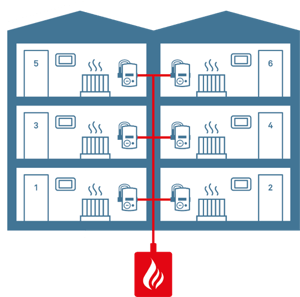It is a well known challenge that heat networks can be perceived as a monopoly. But why? And how are heat networks different to the national grid and domestic gas boilers?
Understanding the differences
Due to the complexity of a heat network, it can be tricky to understand the roles and responsibilities of the supply chain, and even more so when it comes to switching suppliers.

Unlike traditional domestic gas boilers, where each home is connected to the regulated national gas network. A home receiving heat from community heating is connected to a privately owned local network; meaning there is only one provider responsible for supplying heat to everyone in the building or in some cases, to an estate. A heat network is usually owned by the building owner, who is also responsible for all aspects of providing heat to the residents.
Going back 60 years ago or more the gas and electricity networks were owned and operated in a similar way, by local companies. It has taken almost 100 years to get them to where they are now. During this time period more than 25 million homes were connected, technical standards were harmonised and legal and regulatory frameworks developed.
Metering standards are key
But importantly the gas and electricity industries prepared themselves for supplier switching by agreeing set standards for metering and all the data flows and records, providing the process for consumers to change supplier.
Probably the first important step in this process was defining a universal meter point register for both gas and electricity meter points. This is the key concept that allows the switching of meter point billing from one supplier to another.
Could heat networks adopt this method?
Heat networks are still at a small volume stage of housing, with < 0.5 million homes connected, all locally owned and with no harmonisation of metering. The industry has a long way to go before reaching the scalability and standardisation required to enable consumers to switch suppliers.
This however is not as bad as it may sound according to the CMA...
The CMA findings on the monopoly of heat networksThe CMA do consider heat networks to be natural monopolies where residents do not have a choice over who supplies their heat. They point out that the risk of detriment to the resident is substantially reduced when the owners, such as local authorities and social landlords do not have the same profit motives as private operators. They also suggest best place for ownership of in building heat networks is with the owners of the building where the interests of the residents are protected in the same way as all other communal assets. Meaning that the system runs on a not-for-profit basis. |
Our opinion on heat network monopolies
Switch2 certainly support this observation. Whilst still acknowledging that the measure that the CMA are proposing to protect consumer interests; it can only deliver much needed improvements in the experience of residents living in buildings that benefit from community heating.
Shifting the focus to customer services
A way to address the challenge of being a monopoly is providing a great customer experience. By working on the experience of the services, suppliers can build up a level of trust with the resident, allowing for the need to switch, to dissipate instead.
There is an emerging shift in focus for community heating schemes, from the nuts and bolts - or the pipes and valves - to the customer experience and satisfaction. Afterall, the residents are the ones paying and using the services of a heat network, so deserve the best service possible to give them the bang for their buck.
Final thought:
In a country where we have been brought up to think that an energy is supplied nationally and you have the right to switch your supplier to receive quality and value for money. There is a possibility that heat networks will demonstrate that (when the heat network belongs to the local community) there is no need to offer the right to switch supplier to deliver low cost and exceptional service!
Key takeaways
|



